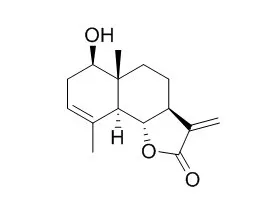| In vitro: |
| Cancer Chemother Pharmacol. 2009 Jun;64(1):143-52. | | Anticancer activities of sesquiterpene lactones from Cyathocline purpurea in vitro.[Pubmed: 18998133] | Cyathocline purpurea has been traditionally used to treat various diseases including cancers for many years. However, these applications of C. purpurea have not been supported by pharmacological investigation. The objective of this study is to investigate the anticancer activities of three main constituents such as Santamarine, 9beta-acetoxycostunolide and 9beta-acetoxyparthenolide isolated from C. purpurea in vitro.
METHODS AND RESULTS:
Cell viability was determined by trypan blue exclusion and methylene blue assays. Colony formation was assessed by microtitration cloning assay. DNA synthesis was determined by tritiated thymidine incorporation assay. Cell cycle analysis was carried out by flow cytometry. Apoptosis was observed by DAPI staining assay and Caspase 3/7 activities was measured using Caspase-Glo 3/7 assay kit. Santamarine, 9beta-acetoxycostunolide and 9beta-acetoxyparthenolide inhibited the growth of L1210 murine leukaemia, CCRF-CEM human leukaemia, KB human nasopharyngeal carcinoma, LS174T human colon adenocarcinoma and MCF 7 human breast adenocarcinoma cells in vitro, with IC(50) in the range of 0.16-1.3 microg/mL. In L1210 model, Santamarine and 9beta-acetoxycostunolide inhibited L1210 cell growth, colony formation and [(3)H]-thymidine incorporation in time- and concentration-dependent manners. Flow cytometry studies showed that Santamarine and 9beta-acetoxycostunolide blocked L1210 cells in the G(2)/M phase of the cell cycle. DAPI staining and caspase activity assays showed Santamarine and 9beta-acetoxycostunolide induced apoptosis and activated caspase 3 in L1210 cells.
CONCLUSIONS:
These results indicated that Santamarine, 9beta-acetoxycostunolide and 9beta-acetoxyparthenolide exhibit significant anticancer activities in vitro. The inhibitory effects of Santamarine and 9beta-acetoxycostunolide on L1210 cells are cytotoxic rather than just cytostatic. They block mitosis and reduce uptake of thymidine. The mechanism of the cytotoxicity of Santamarine and 9beta-acetoxycostunolide to L1210 cells could be related to alkylation of the sulfhydryl enzymes involved in nucleic acids and protein synthesis, as previously found for other sesquiterpenes with the alpha-methylene-gamma-lactone moiety present in Santamarine, 9beta-acetoxycostunolide and 9beta-acetoxyparthenolide. It may also be related to suppression of microtubular proteins. Santamarine and 9beta-acetoxycostunolide induced apoptosis of L1210 cells via activation of caspase 3. | | Pharmaceutical Biology, 2016, 14 May, 54(11):2623-8. | | Reynosin and santamarine: two sesquiterpene lactones from Ambrosia confertiflora with bactericidal activity against clinical strains of Mycobacterium tuberculosis[Reference: WebLink] | Two sesquiterpene lactones (SQLs) with mycobactericidal activity were identified: Santamarine and reynosin.
METHODS AND RESULTS:
Reynosin was the most active compound, with a minimal bactericidal concentration (MBC) of 128 μg/mL against the H37Rv, 366-2009 and 104-2010 Mtb strains and a minimal inhibitory concentration (MIC) of 64, 64, 128, 128 and 128 μg/mL against the H37Rv, 104-2010, 63-2009, 366-2009 and 430-2010 Mtb strains, respectively. Santamarine had MBCs of 128 μg/mL against the H3Rv and 104-2010 Mtb strains and MICs of 128 μg/mL against the H37Rv, 366-2009 and 104-2010 Mtb strains. We also isolated 1,10-epoxyparthenolide but only showed mycobacteriostatic activity (MIC 128 μg/mL) against the Mtb strain. Compounds were tested against the L929 cell line and the calculated selectivity index was <1. |
|






 Cell. 2018 Jan 11;172(1-2):249-261.e12. doi: 10.1016/j.cell.2017.12.019.IF=36.216(2019)
Cell. 2018 Jan 11;172(1-2):249-261.e12. doi: 10.1016/j.cell.2017.12.019.IF=36.216(2019) Cell Metab. 2020 Mar 3;31(3):534-548.e5. doi: 10.1016/j.cmet.2020.01.002.IF=22.415(2019)
Cell Metab. 2020 Mar 3;31(3):534-548.e5. doi: 10.1016/j.cmet.2020.01.002.IF=22.415(2019) Mol Cell. 2017 Nov 16;68(4):673-685.e6. doi: 10.1016/j.molcel.2017.10.022.IF=14.548(2019)
Mol Cell. 2017 Nov 16;68(4):673-685.e6. doi: 10.1016/j.molcel.2017.10.022.IF=14.548(2019)